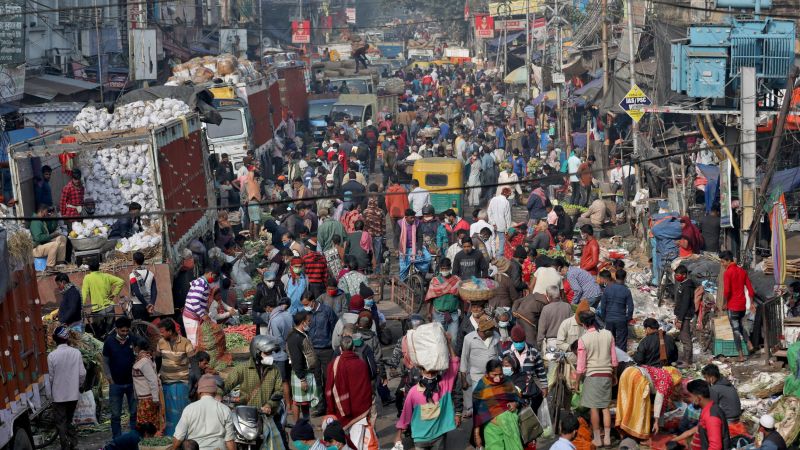How India’s population exploded to overtake China’s and what’s next

CNN
—
Counting millions of people is never an easy task, but the United Nations says its latest calculations show that by the end of this weekend, India will have more people than China, marking an epochal shift in global demographics.
Most of the world has grown up with China holding the title of the world’s most populous country, but decades of restrictive policies limiting families to one child dramatically slowed China’s birth rate, allowing India to pull ahead.
But having a chart-topping headcount is not necessary a title that most countries covet.
A few years ago, Prime Minister Narendra Modi expressed concern about India’s “population explosion” and lavished praise on families who carefully considered the impact of more babies — on themselves, and the nation.
“In 21st-century India, the ability to fulfill dreams starts with a person, starts with a family. If the population is not educated, not healthy, then neither the home nor the country can be happy,” Modi said.
So how did India’s population get so big, and how long will it last?
CNN analyzed the UN’s World Population Prospects data and spoke to experts to delve beneath the headline numbers at the detail surrounding India’s demographic shift.
Not surprisingly, fertility is key to understanding what drives the rise or fall of a country’s population. It is commonly accepted that a country’s average fertility rate — children per woman — must be 2.1 for the population to sustain itself — and even more to grow.
Back in the 1960s, when today’s grandparents were having children, India’s fertility rate was 6, around the same rate as some African countries now.
But, according to the government, India’s total fertility rate dropped to 2.0 in the latest nationwide assessment period from 2019 to 2021, down from 3.4 from 1992 to 1993. The rise in population despite a drop in the fertility rate can be explained by “demographic momentum.”
“When the fertility rate drops, the population continues to grow for several decades. And that is because younger, large cohorts are still growing into that age when they become parents,” said Frank Swiaczny, senior researcher at the Federal Institute for Population Research.
So, even with a replacement or sub-replacement fertility rate, India’s population will continue to grow slowly because of the considerable number of women entering their reproductive years.

Not surprisingly for a nation of its size, India’s fertility rate is uneven across the country, contributing to a north-south divide that sees more babies produced in the north. But even there, the numbers aren’t off the charts.
“What really surprised us is that the highest fertility rate in India — 3.0 in Bihar — is not even that high,” said Barbara Seligman, chief strategy and growth officer and senior vice president at PRB, a nonprofit group that focuses on demographic data and population research.
“It is really striking to see just how many states are below replacement level,” Seligman added. All but five states — Bihar, Meghalaya, Uttar Pradesh, Jharkhand, Manipur — are at that level, and notably, they’re all in the north.
In southern states, a different pattern emerges.
For example, Goa has a fertility rate similar to certain countries in southern Europe, which are currently struggling to support an aging population with a shrinking workforce. It’s a trend experts say India’s leaders would be wise not to ignore.
According to the UN’s classification, India is now an “aging society” meaning that 7% of its population is age 65 or older. In some states, for example in Kerala in southern India, the population over 65 has doubled in the last 30 years and is now at 12%.
The same pattern will extend to more states given the low total fertility rate.
“We’re going to see more and more states over the course of the next 30 years aging in the way that Kerala is now,” Seligman said.
India may have overtaken China in total population, but UN data also shows that its growth rate has slowed.
Between 1971 and 1981, India’s population was growing on average 2.2% each year. By 2001 to 2011, that had slowed to 1.5% and is even lower now. According to UN projections, India’s population is expected peak at about 1.7 billion in 2064.
Right now, more than 40% of the country’s residents are younger than 25, and the estimated median age in 2023 is 28 — nearly a decade younger than China’s — according to UN data.
In 2021, India’s working-age population stood at more than 900 million and is expected to hit 1 billion over the next decade, according to the Organization for Economic Cooperation and Development (OECD).
Not only is this massive — and relatively low-paid — labor force young, it is largely English-speaking, digitally literate and has a reputation for entrepreneurship, making the country a big draw for Western companies seeking an alternative manufacturing hub to China.
But India’s contribution to the share of the world’s working-age population is expected to slow in coming decades, making way for a younger population of workers emerging from Africa.
India may have the lion’s share of today’s working-age people, but experts say the nation needs strong policies to capitalize on its youth.
“A large number of people is not enough, we need to come up with a holistic plan,” Sonalde Desai, director at National Council of Applied Economic Research (NCAER) and professor at the University of Maryland, told CNN.
“We need people who have the skills to fill some of the high-value jobs and an economy that produces these high-value jobs.”
Poonam Muttreja, the executive director of the Population Foundation of India, said addressing the gap is “imperative for India to progress to fulfill its aspirations of being a developed country.”
Though it remains one of the world’s poorest countries per capita, India is moving up the global economic league tables — its nearly $3.5 trillion economy is now the world’s fifth largest and among the fastest growing.
In 2023, the World Bank expects India to outperform all other major economies with growth of 6.6% — compared to 4.3% for China and just 0.5% for the United States, while on some projections it is expected to take the number 3 spot within the next 10 years and become only the third country with a GDP worth $10 trillion by 2035.
Yet despite its fortunes, India’s wealth is not evenly spread.
Poverty remains a daily reality for millions of Indians, and experts say while the country has a large population of young people ready and willing to work, comparative to other countries, figures show there aren’t enough jobs for them.
The problem is worse in economically disadvantaged regions in the north, which rely heavily on agriculture. Uttar Pradesh, for instance, is home to 17% of India’s population but has only 9% of its industrial jobs.
Sabina Dewan, a senior visiting fellow at the Center for Policy Research, says population growth can be a “tremendous productive force for the economy” but economic growth “hinges on providing good quality, productive, and well-remunerated jobs.”
And that starts with investing more in education beyond primary school, especially for women.
“We need to strengthen our secondary school system, make it safer and closer to where the girls are, because many parents do not send their daughters to secondary schools, which are far away, because of security issues,” Muttreja said.
Once they leave school, women’s participation level in the work force — the estimation of the active workforce and people looking for work — was just 19% in 2021, World Bank data shows. That’s less than half the overall labor force participation rate of 46%, already one of the lowest in Asia. The comparative rates for China and the United States were 68% and 61%.
Not only does India need better policies to put women in work — they need to ensure they’re able to stay there, said Desai. For that, more options are needed for temporary contraception to give women more control over childbearing, she said.
Education is the best contraceptive pill that can be given to a woman, Muttreja added.
Dewan, from the Center for Policy Research, said if India doesn’t get the balance right, it risks squandering the considerable advantage of being the world’s most populous country with the world’s largest share of working age human capital.
“The challenge of educating, providing training, and enough good quality jobs is huge,” she said.
“If we don’t create enough good jobs, we waste the tremendous potential of our workers. And we could be looking at a youth population that has greater aspirations than ever before, but few opportunities for income generation.”







